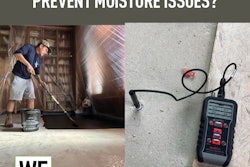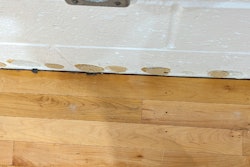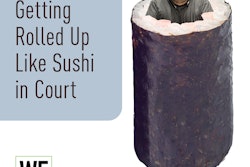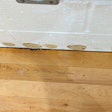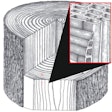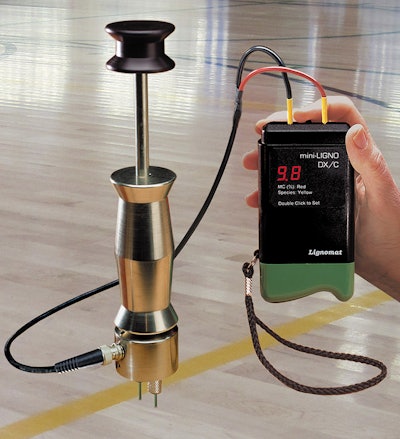
In the "good old days" wood floors were made from solid pieces of wood with tongue and groove, installed and finished on site. Then, came prefinished floors. Nowadays, a wide variety of materials is available from finished and unfinished solid floors to all kinds of engineered floors, bamboo floors and many different subfloors. All these materials are hygroscopic, which means they will absorb and lose moisture and they can cause moisture problems. To avoid moisture problems, the MC should be measured and kept within a permissible range from the time the floor is manufactured to the time the installation is finished and even afterwards.
This article covers three ways to use a moisture meter correctly.
1. Measuring moisture in solid wood floor planks.
2. Measuring moisture in engineered wood floors, panel products and bamboo.
3. Taking comparative moisture measurements.
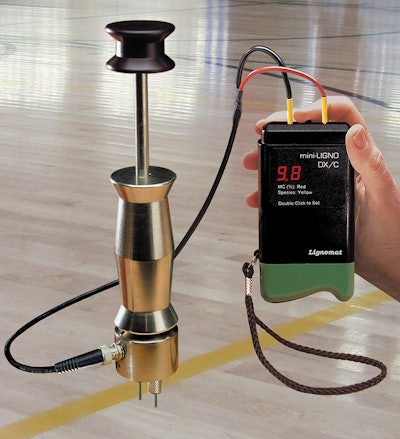 Pin meter mini-Ligno DX/C comes with correction settings for domestic and tropical wood species. Slide hammer electrode is used to measure the moisture of the sub floor without removing floor planks.
Pin meter mini-Ligno DX/C comes with correction settings for domestic and tropical wood species. Slide hammer electrode is used to measure the moisture of the sub floor without removing floor planks.
1. Measuring moisture in solid wood floors is straightforward
First you dial the correction setting for the wood species, and next you take measurements. When dealing with a solid floor, there is no question which setting should be used. You would choose the setting recommended by the floor manufacturer. Most moisture meter manufacturer offer a list of built-in corrections for different wood species for both pin and pinless meters. These corrections are done by setting a code number before taking measurements.
It is absolutely necessary to correct meter readings for the measured wood species, otherwise the moisture percentages indicated by the meter are not correct. Correction setting for pin versus pinless meters are based on different principles.
Corrections for pinless meters are dependent on the specific gravity of the wood species. Therefore, Lignomat's correction settings for pinless meters are directly related to the specific gravity of the wood species to be measured. For instance, the correction setting for red oak is 60; the average specific gravity of red oak is 0.6. Wood species with the same specific gravity can be measured with the same correction settings. The validity of the settings can be confirmed with an oven test.
This method of using the same correction settings for wood with the same specific gravity, does not work for pin meters. Customers with pin meters looking for a correction setting for an unlisted wood often tell us the specific gravity of a wood species because they believe this is helpful information to find the correction setting for the pin meter, but that is the wrong information. Corrections for pin meters are calculated after an oven test has been performed. There is no correlation of pin meter corrections to the specific gravity. Pin meter correction factors have to be found by an oven test and are based on mathematical calculations wet weight/dry weight following the ASTM standard D4444. We supply a list of the most common wood species with each meter. However, new and previously unused wood species appear all the time. They are not listed on the chart. We offer to our customers that we can perform oven testing to find the correct setting for any new wood species free of charge. This helps Lignomat to be up-to-date and helps our customers set their meters to the correct setting even for new species introduced to the flooring industry.
 The dual-depth Ligno-Scanner SDM is ideal for flooring applications. If you choose the ¼-inch setting measurements are never influenced by the subfloor or the concrete underneath.
The dual-depth Ligno-Scanner SDM is ideal for flooring applications. If you choose the ¼-inch setting measurements are never influenced by the subfloor or the concrete underneath.
2. Engineered floor products
The big question is: How can the right correction settings for the many new engineered floor planks be found? Even looking only at engineered oak floors, there are many different types of engineered oak floors. The floors differ from manufacturer to manufacturer in thickness of wear layer and wood species for the core material and number of layers of core material. To get accurate readings, the right correction setting for the meter has to be found for each type of engineered floor.
Our suggestion is to start with a few well acclimated sample pieces. They can be found in a showroom or after acclimation on-site, or it could be a sample piece a customer kept. If the average relative humidity in the area where the floor planks were kept was around 45%, then the MC of the sample pieces should be around 8.5%. If the average relative humidity is different, use the EMC chart to find the corresponding moisture content. Now it is one easy step to find the correction setting for the pinless meter to give the correct readout of 8.5%.
To start the calibration process, set the Lignomat dual-depth scan meter on setting number #50 and the depth to ¼" deep. Then change the setting repeatedly until you get an 8.5% readout. Repeat this process for all sample boards and note all the settings and take the average. That setting can be used in the future for that particular engineered floor plank. Lignomat's dual-depth meters are Ligno-Scanner SD and SDM, Ligno-DuoTec BW and Ligno-VersaTec.
You will find that some floor planks can be measured accurately with the species setting of the wear layer. For other samples you may find different settings than the wear layer are needed.
If no acclimated sample piece is available, set the meter to the wood species of the wear layer and check the wood. Consider the readings you get to be comparative measurements (see the next paragraph). The values will at least indicate if all samples have the same MC or if there are big variations.
It is a lot harder to find the correction setting for a pin meter because the correlation between the settings is not linear. For pin meters, call the meter manufacturer. If the wood species has never been tested before, it may be necessary to send samples to the meter manufacturer for testing.
Measuring Bamboo floor planks and other panel products. When Lignomat first tested bamboo floors about 10 years ago, we started with the oven test method: measure, oven dry, calculate. The oven-dry based MC we found for bamboo were too low to be realistic and correct. We had to base our correction factors on what is called the wood moisture equivalent (WME). For example, if bamboo was acclimated besides a piece of wood and the wood would read 12%, then the meter would be adjusted and corrected to read 12% when measuring bamboo.
This made it easy for the floor installer to use the Ligno-Scanner SDM, the Ligno-DuoTec BW and the Ligno-VersaTec for bamboo floor planks, because the values could be easily related to wood MC. For instance, at a relative humidity of 35% (EMC chart) wood is stable if its MC is 7% same is true for bamboo at 7% measured with the new correction settings. Lignomat's calibrations for bamboo are based on a different base curve as used for wood species corrections.
 The dual-depth moisture meter SDM has correction settings for wood species with specific gravity 0.3-1.0. Lignomat's bamboo correction settings are pre-programmed in the SDM meter also.
The dual-depth moisture meter SDM has correction settings for wood species with specific gravity 0.3-1.0. Lignomat's bamboo correction settings are pre-programmed in the SDM meter also.
3. Taking comparative readings
As the name already says, compare readings. The information gained by taking comparative measurements is this: If all pieces have the same MC or higher values, that means more moisture, while lower values mean less moisture. This can only be applied if the measurements were taken with the same correction setting in the meter at the same measuring depth.
This method becomes more meaningful if a dry piece of the material is available. The measurements can now be compared to the dry value.
This is often done in the restoration industry to detect water infiltration into walls, ceiling, roofs, etc. First step is to find a dry sample piece of whatever you want to measure and then compare the measurements of questionable areas to the dry sample.
Measuring moisture has become an important task for anyone dealing with wood floors, starting with manufacturing up to having the floor installed. If moisture problems occur, it is always helpful if there are records available to see what the floor measured before and compare to what the floor measures now. Obtaining moisture measurements and keeping records gives you the key to understanding wood floor problems.
For more information on Lignomat meters, go to www.lignomatusa.com/moisture-meters/.
For a complete EMC chart go to www.lignomatusa.com/emc/.















